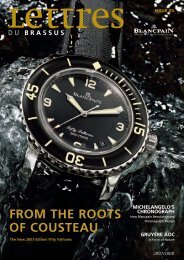THE HISTORY OF BLANCPAIN
THE HISTORY OF BLANCPAIN
THE HISTORY OF BLANCPAIN
Create successful ePaper yourself
Turn your PDF publications into a flip-book with our unique Google optimized e-Paper software.
IN TIME<br />
The Blancpain Rolls.<br />
The Blancpain Harwood.<br />
JEAN-CLAUDE BIVER, <strong>BLANCPAIN</strong> CEO 1982-2002.<br />
tion than prevailed in Europe. The opening<br />
which Fiechter found was as a movement<br />
supplier. Over time, Blancpain became a principal<br />
supplier of Gruen, Elgin and Hamilton.<br />
A further blow came with the disappearance<br />
of Fiechter’s co-owner, André Léal, on<br />
the eve of WWII.<br />
Despite these challenges, Betty Fiechter<br />
succeeded enormously. Joined in 1950<br />
by her nephew Jean-Jacques Fiechter the<br />
Blancpain business became a powerhouse,<br />
both in respect of watches sold under the<br />
Blancpain name and as a movement manufacturer.<br />
Their string of triumphs included<br />
the Fifty Fathoms, the world’s first modern<br />
diving watch which debuted in 1953 (see<br />
Issue 3 of “Lettres” for the comprehensive<br />
history of how Jean-Jacques Fiechter developed<br />
this iconic watch in collaboration with<br />
the French combat divers and presided over<br />
not only its widespread adoption by navies<br />
around the world, but its use by Jacques<br />
Cousteau and his team) and the Ladybird<br />
women’s watch appearing in 1956 and featuring<br />
what was then the world’s smallest<br />
round movement. On the back of these<br />
milestones, the Fiechters guided Blancpain<br />
to a production level of over 100,000 watches<br />
per year by 1959.<br />
As Rayville-Blancpain grew it became<br />
increasingly apparent that the Fiechters<br />
needed additional resources to expand production<br />
to the level of demand. Betty Fiechter<br />
found the solution in 1961 via a merger into<br />
Société Suisse pour l’Industrie Horlogère<br />
(SSIH). Joined into SSIH were Rayville-Blancpain,<br />
Omega, Tissot and Lemania. Rayville-<br />
Blancpain became one of the production<br />
bulwarks of the group, building new facilities<br />
and soaring its production to over 220,000<br />
pieces by 1971.<br />
The Fiechter legacy fell solely into Jean-<br />
Jacques’ hands following Betty’s death in<br />
1971. Jean-Jacques would soon be sorely<br />
tested by what some in the industry called<br />
the perfect storm of the mid-70s which<br />
brought together the introduction of compe-<br />
tition by quartz watches, the melting of the<br />
dollar against the Swiss franc (sending the<br />
prices of Swiss watches in the most important<br />
market to unprecedented levels), the oil<br />
crisis and a global recession. In combination<br />
these market forces plunged the production<br />
of SSIH in 1979 to less than half of what it<br />
had been before, generating huge losses and<br />
precipitating a crisis with their banks.<br />
SSIH’s response to this pressure saw both<br />
arrivals and departures in the early 80s.<br />
Arriving in 1980 was the engineer Nicolas<br />
Hayek who later came to found the Swatch<br />
Group under whose ownership Blancpain<br />
now flourishes. Desperate to generate cash<br />
in all ways, SSIH turned to selling its patrimony.<br />
First on the block was the movement<br />
manufacturer Lemania (today Lemania, now<br />
merged into Breguet, is part of the Swatch<br />
Group aside Blancpain). Next was the name<br />
Blancpain which was sold to a partnership of<br />
movement manufacturer Frédéric Piguet, led<br />
by Jacques Piguet, and Jean-Claude Biver,<br />
then an employee of SSIH. Only the name<br />
Blancpain was sold by SSIH; the assets of<br />
Rayville-Blancpain, that is to say its movement<br />
manufacturing facilities and equipment,<br />
remained fully in operation continuously<br />
through the time of the sale.<br />
Together Jean-Claude Biver and Jacques<br />
Piguet opened a new chapter in the two and<br />
a half centuries’ old history of Blancpain.<br />
They transformed Blancpain from a company<br />
that had hidden much of its savoir faire by<br />
emphasising the production of high quality<br />
movements which would be sold under the<br />
names of others and letting sales of watches<br />
under its own name dwindle to but a few<br />
thousand pieces a year, to one which would<br />
keep its creations and inventions for itself.<br />
The chronicle of the remarkable string of<br />
world first accomplishments running through<br />
to today is now memorialised in the Tradition<br />
of Innovation section of Blancpain’s catalogue.<br />
Read our catalogue online:<br />
www.blancpain.ch/e/downloads/catalogues







